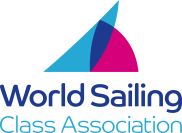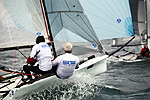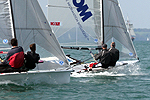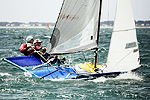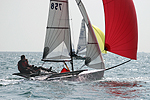A scaled-down 18 foot skiff the B14 delivers exhilarating sailing, high quality international racing and as much fun as you can handle. It is the fastest two person ‘body-swung’ sailing boat in the world. Hiking from the wide wings, blasting along at 20 knots with over 50 sq.m. of downwind sail area is like nothing else in the world. It is a drug that attracts a growing number of addicts around the world.
As an ISAF Recognised Class, we hold World, European and National Championships at the best venues in Europe, and Australia. Our aim is to provide simple, one design, low-cost sailing for people who enjoy the adrenalin rush of sailing light-weight, high performance skiffs
The Boat
The B14 is a world-wide club racer with outstanding qualities. A thoroughbred, born ahead of its time and now has finally matured. This unique design is like no other 14 footer. It encompasses the main features of the 18ft skiffs, to bring back exhilaration and fun to high performance sailing. The use of large hiking racks which support both crew outboard generate the power to attain exhilarating speed.
The boat is built for racing and possesses a power to weight ratio technically far superior than any other boats in this category. The B14 commands great acceleration and stability in high winds. The clean features, light weight loads of the B14 puts sailing expertise at the forefront and leaves 'brute' force for the heavier boats. Due to the methods applied in the construction of the boat, it is highly resilient to high performance racing, and hence has a low maintenance cost.
The boat's performance is indisputable and its design can only be described as innovative. A craft that is respected for its speed, agility and finesse. It is easy to sail but is technically challenging to race well.
Classes are established around the world where the B14 currently provides close racing where women represent 10% of the class. Because of the light loads and the emphasis on technique rather than power, women excel in this class. Since the B14 uses hiking racks, the differential in righting moment over weight, which does effect performance, is significantly reduced between short and tall people as compared to trapezing. As was discovered during the prototyping of the B14, and now globally accepted in this type of boat, crew weight (within a very broad range) is significantly less of a factor than with other heavier boats. Again, because the boat is twin hiking, the usual requirement of 'larger person on the wire, smaller person on the helm' does not apply.
The B14 has proven to be popular with the new breed of sailors who are looking for the thrills of 18 ft skiff sailing at a low cost.
The B14, irrespective of crew weight, is all about subtlety, agility, grace, finesse, elegance, rhythm and balance.
The History
The B14 was designed in 1986 by 18ft skiff champion Julian Bethwaite. The design of the boat is modelled on his two handed 18ft skiff 'Prime III' which incorporated many innovative concepts such as the asymmetrical spinnaker and the two man crew. The blend of skiff ideas, such as hiking racks, retracting spinnaker pole, asymmetric spinnaker, flexible topmast and a dish-like cockpit makes the B14 an attractive boat.
In the initial development of the boat a weight equalisation system was used. This however was proven to be of no benefit.
In 1987 the B14 was launched in Australia. Since then fleets have also grown in Japan and Hong Kong. In 1993 Rondar Raceboats Ltd launched the B14 into Europe. There are now boats in many European countries.
As the boat has had a maturing period in which a limited number of improvements have been made to the boat and the construction methods, there is now little room for specification changes which would enhance performance.
There is no strong marketing machine behind the B14. The Designer and Boat Builders have relied on the quality and characteristics of the boat to help build and promote the class. This helps to keep the retail cost to a minimum. The B14's main promotional activity is through exposure at events, training and demonstrations, and Dinghy Shows.
The Characteristics
Outstanding power to weight ratio is the key to the B14's blistering performance, which is enhanced by a sophisticated rig. A wide range of body weights can remain competitive in all conditions and because of the light loads and easily driven hull form, it returns an outstanding performance for effort.
The positive steering and directional stability in high winds are impressive and this makes it easy to sail both upwind and downwind. A fully battened main and a large genoa produces exhilarating speed to windward, this is dramatically boosted by the easy to handle asymmetric spinnaker off the wind. The mast features a glass fibre top section to both reduce weight and to offer outstanding flexibility in strong winds, thus providing perfect gust response. The extended wings allow the crew to drive the boat with greater control and balance, while the asymmetric spinnaker, set from a retractable bowsprit, makes gybing easy, encouraging "downwind tacking" in any condition.
Easily managed on shore, the B14 can be easily carried to and from the water by three people and can be towed or carried on a roof rack. The detachable wings fit neatly on the deck.
The B14 is very stable in heavy winds due to the wide rack configuration which allows the crew to drive the boat fast. It is very simple to rig and to transport and has the added value of beating most boats on the water. This is a truly exciting "One Design" concept that has lead the revolution into high performance dinghy sailing.
Both women and men find the boat challenging and exciting to sail. It is a boat that can be learned to sail quickly and easily but requires a considerable amount of technique to sail at top level. This enhances the class whereby beginners can acquire skills by competing with those at advanced levels. Most owners of the B14 love their boat and did not buy due to media and marketing pressure, but for the boat itself. The B14 is a pure adrenaline racing machine, but is also a boat that people enjoy sailing.
It possesses the acceleration of an 18ft Skiff, but at a fraction of the cost.
The Construction
The B14 features a construction for strength and panel stiffness. The use of PVC foam sandwiched by S and E glass skins laminated with polyester resin (epoxy on some early boats and the latest Ovington hulls) and a gel coat finish ensures a rigid and robust hull. Extra strength at the bow is due to laminated foam/glass Y frame.
The simplicity of the design can be deceiving, it has taken years of development to create a high performance boat with a streamline rig and clean look. Julian has developed a fast boat for the highly skilled, but robust enough for the new comer. A boat suitable for both men and women to compete at the same level technically.
The B14 has proven that it is a sturdy boat of long lasting construction which has been tried and tested for many years. The standard and quality of the materials used are of the best attainable.
The Attributes
A simple light weight hull with minimalist racks, spars, foils, sails and working loads. A scooped deck provides a low centre of gravity. The mast is set well back in the boat to allow for the large asymmetrical spinnaker and for improved speed in up-wind planing conditions. The flexible mast tip accommodates a larger range of mainsail shapes purely by use of the cunningham and provides the sailor with superb gust response, crucial to a light weight planing hull.
The foils are light weight with flexibility to match the gust response of the mast. They are designed for low drag for down-wind performance and up-wind pointing ability.
The asymmetrical spinnaker is flown from the end of the short retractable bowsprit and from just above the cap shroud spreaders. The narrow asymmetrical together with the light weight hull ensures extremely light sheeting loads. The five battened, roachy main can be reefed in winds of over 20 knots without affecting performance, and allows lighter crews easier control. A simple zipped luff jib with minimal over lap ensures increased pointing in planing conditions.
The ends of the wings simply slot into pins mounted in the centre of the hull and the transverse beams drop into recesses in the gunwale where they are firmly pinned. The bowsprit inserts simply into an outer tube embedded in the hull itself.
The hull and rig are all "One Design" so construction is to an exact specification, and the design incorporates an open transom for rapid draining.
For the cost, in relation to speed and sailing technique acquired from mastering a boat such as the B14, there is nothing as comparative on the market. The boat represents value for money. It is light, the loads are light and there is no need for a weight equalisation system to allow a wide range of weights to sail. Both heavy weights and light weights can compete at the same level were technique and sailing expertise become the main criteria.
The Future
With interest in the boat at its highest ever, the expectations for the coming year are at an all time high with continuous growth at a steady rate. Now that the Class Associations are in agreement world wide as to what direction they wish to take, there is an even stronger platform for growth.
The B14 Class Associations of the world are in the process of developing a strong and unified infrastructure to promote the class, with the aim of achieving International Status.
With more and more markets maturing to the level required for a successful B14 fleet to establish, the future looks bright. Since, in skiff sailing terms, the Australians are approximately 5 to 10 years ahead of the rest-of-the-world and the boat is still respected and is popular as ever there, this indicates that the B14 will have a long and successful career.
Sydney 2000 was a unique moment in the development of the International B14 Class. For the first time, B14’s from Europe, Australia and Japan raced against each other. For the first time the construction, build quality, equipment specification and layout, rig development and controls could be compared, evaluated and discussed. Prior to the event we heard that the Aussie’s were very concerned that we were about to turn up with boats which had been developed so far away from the original specification, to which their boats are still built, that it would be an unequal contest. Consequently, it was with great relief, when the boats emerged from the container and more importantly when we lined up for the first time on the race track, that the boats looked the same and were equally matched.
The differences that do exist are, in the main, cosmetic. When LDC (previous UK licensed builder) started marketing the boat they introduced a number of changes to improve the usability, efficiency and visual impact of the boat. Fortunately, none of these changes has a performance impact and they were in the main well received by the Australian members. Of particular interest to them was the finished quality of the boat. While we are used to receiving a ready to race, well-sorted product, the Australians have bought their boats as kits and completed the finishing themselves. This has led to more variation in their boats than ours and this is now considered to hinder the marketability of the boat. There was strong desire for them to move to the same model as ours; make it simple - buy a complete boat and go sailing.
The one area of development and contention over recent years has been on sails with the introduction of open sailmaker and the opportunity for sail development. In spite of initial resistance from members who liked the absolute one design Laser One product, there was general acceptance that the new rig was good news. After a quiet period for the Class down under they have built more boats in the last 18 months than in the previous four years. They have attracted a new breed of sailor who want international competition and enjoy the challenge provided by limited sail development.
During the Sydney Worlds we held an open forum with the Class members to hear everyone’s views on the future direction for the Class. There was common agreement on how to proceed; standardise the product, limited development to improve durability and performance, and promote exciting international racing at exotic locations.
Afterwards the World Council sat down with Julian Bethwaite to discuss the views of the membership and agree the future of the Class. The first thing to report is that Julian was very enthusiastic about the Class. Over recent years Julian has had his head 100% into first the 49er, and then more recently the 29er. Consequently, the B14 has not been on his agenda. It is also fair to say that the Australian Class has viewed his motives with some suspicion, fearing that he was developing boats that would compete directly with the B14. Although there is some overlap it is now clear that the B14 is a unique product, and that Julian sees significant opportunities for the Class to develop worldwide. We therefore have his support and active engagement in taking the Class forward, which is excellent news.

